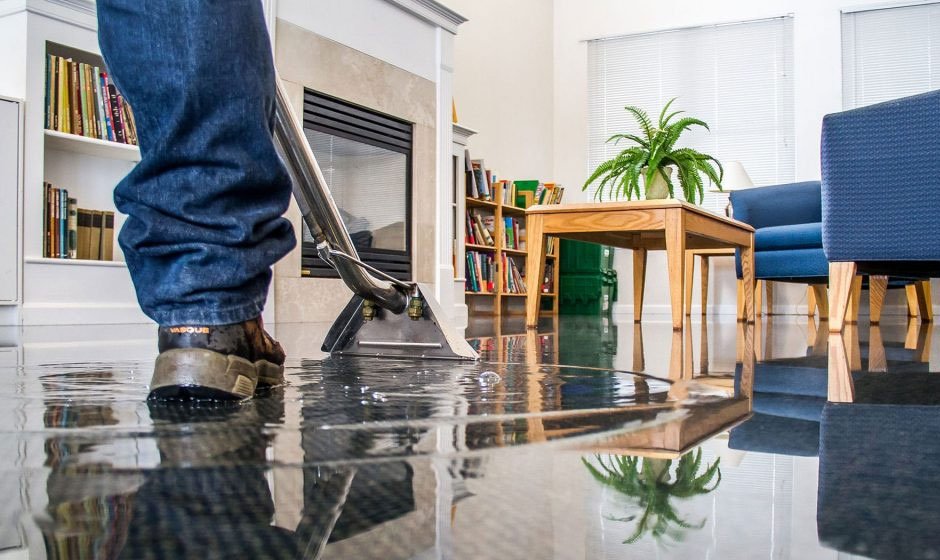Key Takeaways:
- Water damage poses serious risks beyond leaks, affecting health and structural integrity.
- Early signs of water damage include discoloration, peeling paint, and musty odors.
- Ignoring water damage can lead to costly repairs and decrease property value.
- Professional water damage restoration involves assessment, extraction, drying, and remediation of mold.
- Choose certified restoration professionals with good reviews and available emergency services.
- Implement preventative measures like proper drainage and sump pumps to reduce water damage risk.
- Smart home technology, such as leak detectors, enhances protection against water damage.
- Seasonal maintenance is essential for mitigating weather-related water damage risks.
- Understand your insurance coverage and document damage thoroughly for claims processing.
- Maintain communication with insurance adjusters to facilitate a smooth claims process.
The Hidden Dangers of Water Damage: What Every Homeowner Should Know
Understanding the Risks: More Than Just Mold
Water damage is often perceived as a straightforward issue, primarily associated with leaks or flooding. However, the risks extend far beyond mere inconvenience or aesthetic concerns. When water infiltrates your home, it can lead to serious structural problems, the proliferation of harmful microorganisms, and other hidden dangers that could severely compromise your health and well-being. For instance, standing water creates an ideal breeding ground for insects, including mosquitoes, which can transmit diseases. Additionally, prolonged moisture can foster an environment conducive to the development of mold and mildew, with certain strains posing significant respiratory risks and allergic reactions. In some cases, water damage can weaken the very foundation of your home, resulting in costly repairs. Therefore, recognizing these multifaceted risks is paramount for any homeowner looking to safeguard their living space.
Identifying the Signs: When Water Damage Strikes
Identifying water damage is crucial in preventing further issues. Early signs may be subtle yet alarming. Look for discoloration on walls and ceilings, which can indicate water infiltration. Peeling paint and bubbling wallpaper are also telltale signs of moisture buildup. Floors may warp or buckle, particularly if they are made from sensitive materials like hardwood or laminate. Another critical indicator is the smell of dampness or mustiness, which indicates mold and mildew growth. Pay close attention to unusually high water bills—this could mean a hidden leak is silently draining your resources. Homeowners should also monitor the performance of their appliances, especially those that utilize water such as washing machines, dishwashers, and refrigerators with icemakers; any leakage from these could signal developing problems that might not be immediately visible. Recognizing these signs early can mean the difference between a minor repair and a significant and costly water damage restoration project.
Long-Term Consequences: Why Ignoring Water Damage is a Bad Idea
Water damage, if neglected, can lead to severe long-term consequences that homeowners often underestimate. Besides promoting mold growth and damaging property, untreated water damage can compromise the structural integrity of your home. For instance, wooden beams can weaken over time, leading to significant safety concerns. Furthermore, persistent moisture contributes to a deterioration of insulation, which can negatively impact your home’s energy efficiency, leading to increased energy costs. If water damage seeps into the foundation, it can result in issues such as cracks and settling, which may require costly structural engineering solutions to rectify. There’s also the potential for impact on your property value. Homes with a history of unresolved water damage can be considered less desirable when it comes to selling, as savvy buyers may be wary of hidden issues lurking beneath the surface. Thus, addressing water damage promptly is not just a matter of immediate convenience but is essential for your home’s longevity and value.
Professional Water Damage Services: What to Expect and Why They Matter
The Science Behind Water Damage Restoration Techniques
Professional water damage restoration is a meticulous process grounded in science. When water infiltrates your home, certified specialists in water damage services use a systematic approach involving advanced technology and specialized techniques to restore your property. Their primary goal is to remove moisture promptly and efficiently to prevent further damage. One common technique involves the use of industrial-grade equipment, such as dehumidifiers and air movers, which help extract moisture from walls, floors, and ceilings. Specialists also utilize thermal imaging to identify hidden moisture pockets behind walls and underneath floors, a critical step in ensuring comprehensive drying. Additionally, chemical treatments may be employed to combat mold spores, using non-toxic agents that kill mold and prevent its recurrence. By integrating immediate water extraction methods with longer-term preventative measures, water damage services ensure your home not only looks its best but also remains safe and structurally sound.
From Inception to Completion: The Step-by-Step Process of Restoration
The restoration process typically unfolds in several key stages. Initially, professionals conduct a comprehensive assessment of the damage, identifying the source of the water and determining the extent of the impact. This step is crucial as it guides the subsequent actions taken. Following the evaluation, water extraction is performed using high-capacity pumps and vacuums designed to remove standing water quickly. Next comes the drying phase, where advanced air movers and dehumidifiers work tirelessly to pull moisture from affected materials, ensuring that nothing is overlooked. Once the space is thoroughly dried, technicians will then address any potential mold growth, using specialized cleaning agents and techniques to sanitize affected areas. The final stage involves restoring your property to its pre-damage condition, which may mean repairing or replacing walls, painting, and even replacing damaged flooring. Throughout this process, communication remains key; reputable professionals will keep you informed, providing peace of mind as they restore your home.
Choosing the Right Professionals: What Credentials to Look For
Finding the right water damage restoration professionals can make a significant difference in the recovery process. It is essential to look for certifications from recognized organizations such as the Institute of Inspection, Cleaning and Restoration Certification (IICRC) which indicates that the technicians are trained and knowledgeable in proper water damage restoration techniques. Additionally, review customer testimonials and look for companies that offer 24/7 emergency services, ensuring that help is available whenever you need it. Insurance and licensing are also critical indicators; verify that the company is fully insured to protect yourself from liability in case of accidents during the restoration process. Finally, consider the company’s experience in handling similar restoration projects and their track record in satisfactory completions. Thorough research and due diligence can lead you to a reliable professional who can guide you through the restoration process effectively.
Preventative Measures: Protecting Your Home Before Disaster Strikes
Proactive Strategies: Simple Steps to Reduce Your Water Risk
Prevention is always better than cure, especially concerning water damage. Homeowners can implement a multitude of proactive strategies to minimize their risk. One key step is ensuring proper drainage around your property; this may involve directing downspouts away from the foundation and keeping gutters clear of debris. Regularly inspecting your plumbing and appliances for leaks can help identify potential problems before they escalate. Installing sump pumps in basements and crawl spaces is a wise investment that can mitigate the risk of flooding. Additionally, consider using flood alarms that notify homeowners when water is detected in sensitive areas, providing an early warning system for potential leaks. Lastly, create an emergency plan that includes shutting off your water supply in the event of a serious leak, allowing you to act swiftly and avoid extensive damage. By taking these practical measures, you can protect your home from the unpleasant surprises that water damage can bring.
Smart Home Technology: Innovations That Help Prevent Water Damage
In this digital age, technology can play a pivotal role in safeguarding your home from water damage. Smart home systems offer innovative solutions that alert you to problems before they escalate into major issues. For example, smart water leak detectors can be placed in kitchens, bathrooms, and basements, sending real-time alerts to your phone if they detect moisture in areas that should remain dry. Some advanced systems even integrate with your home’s plumbing to automatically shut off the water in the event of a leak, providing an invaluable layer of protection. In addition, smart irrigation systems help manage outdoor watering schedules, reducing water wastage and the risk of over-saturation in your yard. Regular maintenance reminders can also be programmed into your smart home devices, ensuring that homeowners stay on top of their plumbing inspections and repairs. By leveraging cutting-edge technology, homeowners can significantly enhance their defenses against water damage.
Seasonal Tips: Preparing Your Home for Changing Weather Patterns
Seasonal weather fluctuations bring varied risks, making it imperative for homeowners to adjust their water damage prevention strategies accordingly. In the spring, be vigilant about preparing for potential heavy rains; clearing gutters, checking for roof leaks, and ensuring drainage systems are functioning can prevent substantial problems later. In summer, excess humidity can lead to mold growth; consider utilizing air conditioning units that can reduce moisture levels in the air. Fall presents its challenges as leaves clog gutters and downspouts, requiring regular maintenance to avoid backup. Winter weather, particularly freezing temperatures, can lead to burst pipes, so insulating vulnerable areas and maintaining consistent heating levels can avoid burst pipes. Employing seasonal checklists that prompt regular maintenance based on changing weather patterns helps keep your home prepared year-round, significantly reducing risks associated with water damage.
Insurance and Water Damage: Navigating Claims with Confidence
Understanding Your Coverage: What Policies Typically Include
Understanding the nuances of your homeowner’s insurance policy is essential when it comes to water damage. While many policies cover sudden and accidental water damage such as that from burst pipes, they often exclude damages resulting from neglect or poor maintenance, such as slow leaks that go unaddressed over time. Flood insurance, typically sold separately from homeowners insurance, is crucial for properties prone to flooding. Understanding the specific terms of your coverage, including deductibles and limits, can prevent unexpected surprises when filing a claim. Consulting with your insurance agent regularly can provide clarity on what is covered and help you update your policy as needed. Additionally, in the event of a claim, understanding your coverage protects your financial investments and ensures that you can recover effectively after a water damage incident.
Documenting Damage: Best Practices for Filing a Claim
Filing a water damage claim can be daunting, but documenting damage effectively is key to a successful process. Begin by taking comprehensive photographs of all affected areas, ensuring to capture both close-ups of the damage and wider angles that provide context. Create a detailed inventory of damaged items, noting their condition and value; for significant damages, encourage professionals to generate a thorough report of their findings. If applicable, gather receipts for repairs and mitigation steps taken prior to filing the claim. Evidence of neglect, such as unaddressed leaks that may not be covered, should also be minimized through timely documentation. Organizing this information systematically can streamline communication with your insurance company, increase the odds of receiving fair compensation, and diminish the likelihood of disputes later in the process.
Working with Adjusters: Tips for a Smooth Claims Process
Once you’ve filed your claim, working with insurance adjusters becomes a crucial component of the process. First and foremost, maintain open communication; prompt responses to requests for documentation or additional information can expedite your claim. Be prepared to clarify details about the circumstances surrounding the water damage, emphasizing that you’ve taken proactive measures to prevent further issues. Adjusters may conduct their inspections, so be available and cooperative, making sure to point out all areas of concern. Keep thorough records of all conversations and correspondences, as well as document names, dates, and oaths made during the claims process. If necessary, do not hesitate to seek quotes from independent contractors to validate repair estimates provided by your insurance company. A diligent and thorough approach can lead to a smoother claims process and ensure that you receive the compensation you deserve for your water damage restoration needs.






